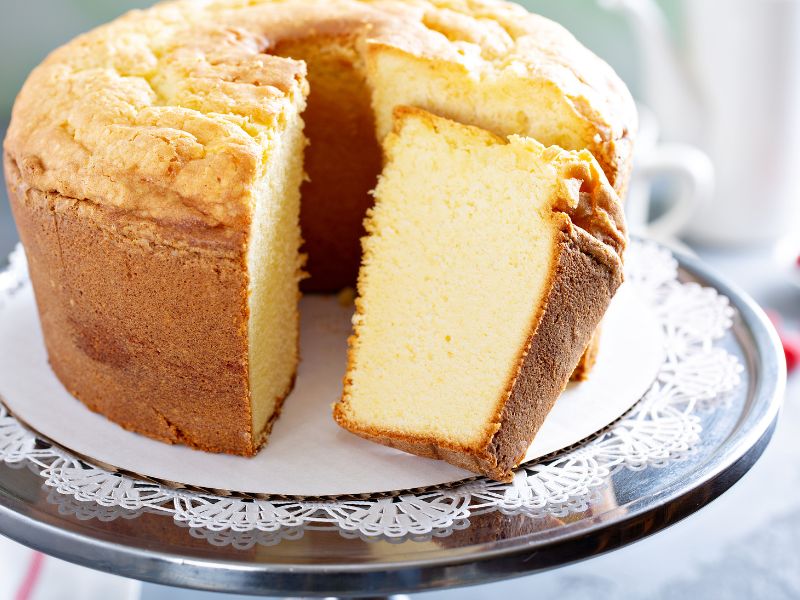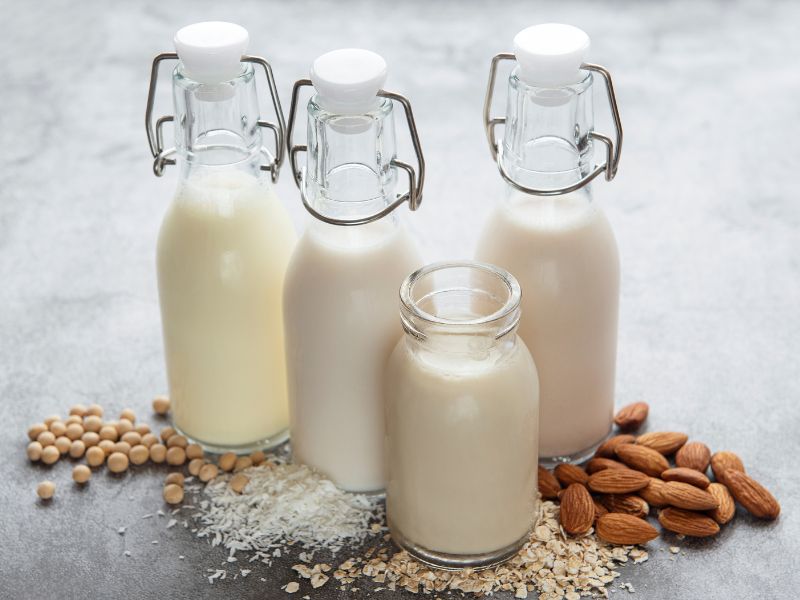When baking, you can substitute 2% milk for whole milk in most recipes. While whole milk has slightly higher fat at 3.25% versus 2% milk’s 2% fat, the difference is small. Using 2% milk may result in a slightly denser texture and less richness, but overall, the results will be similar. For better texture, use the 2% milk at room temperature and add a tablespoon of butter per cup of milk for extra moisture and richness. For baked goods that depend on milk for creaminess and a smooth, rich texture, such as puddings or custard pies, whole milk is the better option.
The Milk Swap

You’ve noticed that most baking recipes call for some milk. But have you ever wondered why? When it comes to baking, milk plays a few different roles.
Moisture and Tenderness – Liquids like milk introduce moisture into baked goods. This moisture produces tenderness in the final product, preventing dryness. Milk helps items like cakes, cookies, and muffins keep a delightful texture.
Richness and Flavor – The milkfat in whole milk lends richness and a creamy flavor. This fat tenderizes and adds juiciness. It also allows for browning during baking for nice color development.
Leavening – Milk reacts with baking soda or powder to help doughs and batters rise. This reaction produces those light, fluffy textures we love in cakes, biscuits, and the like.
🥛 Milk Fat Content & Baking Uses 🍪 |
||
|---|---|---|
| Type of Milk | Fat Content (%) | Recommended Baking Use |
| Whole Milk | 3.25% | Rich cakes, custards |
| 2% Milk | 2% | Everyday baking |
| 1% Milk | 1% | Lighter baked goods |
| Skim Milk | 0% | Low-fat recipes |
| Brought to You by “wearebaking.com” | ||
Whole milk contains around a 3.25% concentration of milk fat. And, of course, 2 % milk has 2 % fat. It may not seem like a dramatic difference, but that slightly higher fat percentage does influence the traits mentioned above.
So if you use 2% rather than whole milk in baking, you may notice slightly less richness and moisture.
Understanding Influences
When you use 2% milk rather than whole milk, the slightly lower fat content may result in slight changes in your baked goods. However, in many recipes, the differences will be minor, and the 2% swap will work just fine.
You may get a bit drier and denser texture results when using 2% milk instead of whole milk in recipes for cookies, cakes, muffins, and other tender baked goods. With less fat from the 2% milk, the crumb might be slightly less tender and moist. Also, the reduced fat content can result in baked goods that are not quite as rich and flavorful since the higher fat content in whole milk provides a lot of that creamy taste.
When it comes to breads, pastries, pie crusts, and other doughs, the influences center more on structure. Whole milk gives more tenderness, which results in a flakier dough or crumb. Using 2% milk may mean your pastry doesn’t get quite the same soft, melt-in-your-mouth quality.
For recipes where milk doesn’t play a major role, you can swap in that 2% without too much worry.
Your chocolate chip cookies may spread a little less, or your cake may dome slightly, but overall, a successful baked good can still be achieved!
🍰 Whole vs. 2% Milk in Baking: Outcome Differences 🧁 |
||
|---|---|---|
| Recipe Type | Whole Milk Outcome | 2% Milk Outcome |
| Cakes | Moister, richer texture | Slightly denser, less rich |
| Cookies | Spread more, tender | Less spread, slightly denser |
| Breads | Softer crumb, richer flavor | Firmer crumb, less rich |
| Pastries | Flakier, tender texture | Less flaky, slightly tougher |
| Brought to You by “wearebaking.com” | ||
Baking Tips
Using 2% milk when the recipe calls for whole milk doesn’t have to spell disaster for your baked goods! You can set yourself up for baking success with a few simple tips.
For Cakes, Cookies, and Muffins
Since these baked goods rely on milk for moisture and tenderness, putting 2% milk to work takes some finesse. Be sure to:
- Use milk at room temperature. Cold milk from the fridge won’t blend in properly.
- Add a pat of butter (1 tbsp per cup of milk) to introduce a bit more fat for richness and moisture.
- Allow your batter to sit for 5 minutes before baking to let the milk hydrate the flour. This improves moisture retention.
- Check doneness early and extend bake time by a few minutes if needed. The denser texture may require more time in the oven.
For Breads and Pastries
Since structure and layering are important here, you’ll want to:
- Use the 2% milk as is without any additions – the fat content will already be decreased.
- Knead dough thoroughly, adding a minute or two to get enough gluten development.
- Be prepared to use a bit more flour if the dough seems too sticky or moist.
With a few easy tweaks like these, your baked goods made with 2% can rival those made with whole! It just takes some awareness of how milk influences whatever you’re baking.
Choosing Whole

While using 2% milk is an easy substitute in most recipes, there are some cases when sticking to whole milk is for the best.
Custards, puddings, cream pies, and flan rely heavily on the milk itself for ultra-smooth, creamy richness. The higher fat content plays a starring role. So for these dishes, choose whole milk whenever possible.
In recipes where achieving an airy, delicate crumb or texture is key, that extra bit of fat can also be important. Think light and fluffy butter cakes, croissants with distinctive flaky layers, or meltingly tender biscuits. The additional fat in whole milk gives structure and moisture.
Of course, when baking, personal preference comes into play, too! If you try a recipe with 2% milk but find it a bit too dense and dry for your liking, consider using whole milk the next time. Also, if a cake sinks more than normal or a batch of cookies spreads poorly, take it as a sign that the fat from whole milk may be better for that particular recipe.
When milk is central to providing moisture, lift, and a melt-in-your-mouth quality, go for whole over 2% whenever possible. But in most everyday recipes, 2% will do just fine.
Alternative Options

While 2% milk makes an easy whole milk stand-in for most recipes, it’s not the only substitution option when you are out of whole milk. Get creative by exploring other dairy and non-dairy alternatives too!
Non-dairy milks like almond, oat, soy, and coconut milk offer unique nutritional benefits. However, their properties differ greatly from dairy milk, so adjustments may be required. Consider the flavor they will give and expect texture changes too.
Half-and-half contains 12-15% milkfat, making it richer than whole milk. But take care not to throw off moisture levels by swapping it as-is. Try cutting half-and-half with water or skim milk in equal parts first.
Tangy and thick yogurt can also work as a creative milk substitute. Thin it out with water first – about 1/4 cup per cup of yogurt. And consider that yogurt may influence flavor and leavening compared to regular milk.
🌿 Alternative Milk Options for Baking 🍰 |
|||
|---|---|---|---|
| Type of Milk | Fat Content | Flavor Profile | Best Baking Uses |
| Almond Milk | Low | Nutty | Muffins, cakes |
| Oat Milk | Medium | Creamy & sweet | Breads, pancakes |
| Soy Milk | High | Mild & rich | Almost all baking |
| Coconut Milk | High | Tropical & rich | Deserts, curries |
| Brought to You by “wearebaking.com” | |||
Don’t feel limited to the familiar when grabbing that carton from the fridge to bake with. Let the above alternative options spark your creativity too! Whether almond milk, half-and-half, or yogurt, explore how these fun substitutions can put a unique spin on your next baked good using what you already have on hand.
Frequently Asked Questions
Still, Have Questions?
Will my cookies spread differently with 2% milk?
Yes, you may find your cookies don’t spread as much since less fat results in a thicker batter. Be prepared for thicker cookies.
Can I use 1% milk instead of 2% milk?
While not ideal, 1% milk can work but may lead to even denser and drier baked goods than the 2% variety.
What if my recipe calls for buttermilk?
You can make your own buttermilk substitute by mixing 1 tbsp lemon juice or vinegar per cup of 2% milk. Let it sit 5 minutes before using.
Key Learning Points:
- You can substitute 2% milk for whole milk in most baking recipes with minimal impact on the final product.
- The slight difference in fat content between whole milk (3.25%) and 2% milk (2%) may lead to a slightly denser or less rich baked good.
- For the best results, consider the type of baked goods and the role of milk in the recipe.
What’s your go-to milk for baking – do you stick with good ol’ cow’s milk or do you get creative with non-dairy alternatives? Have you ever used 2% milk instead of whole milk in baking? I’d love to hear about your kitchen experiments and substitutions! Please leave a comment below.
And As Always
Keep On Baking!
Taianne
Share the Love

I’m Taianne, the owner and operator behind We Are Baking. Baking my first cake at age 11 hooked me on creating sweet treats. Though my interest faded during childhood, it was rekindled when I married my apple pie-loving husband. I love trying new recipes, tweaking classics, and helping others learn the science and art of baking. I started We Are Baking to share tips, tricks, and favorite recipes I’ve discovered over the years. When not in the kitchen, I enjoy spending time with family and friends. My goal is to inspire others to embrace their creativity through baking. Feel free to contact me with any questions!
Taianne@wearebaking.com

